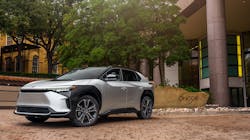Texas grid giant Oncor collaborating with Toyota on Vehicle to Grid research pilot
The rising tide of vehicle electrification in the U.S. could push peak demand to unprecedented heights, requiring multi-billion-dollar expenditures across various grids nationwide. In California alone, a report by the Smart Electric Power Alliance anticipates some 4.9 GW in EV load expansion by 2030.
So the potential vehicle to grid (V2G) technology offers a counterpunch to that coming force.
Texas-based electric transmission owner Oncor Electric Delivery will explore the V2G possibilities under a first-ever collaboration with Toyota Motor North America. The pilot project will enact and examine V2G technology allowing EVs to flow some energy from the battery back into the electric grid.
The effort will be led by Toyota’s Electric Vehicle Charging Solutions team. It is the auto maker’s first collaboration with a public utility in the U.S.
“Electrification is coming, and it’s Oncor’s job to build a safer, smarter, more reliable electric grid that can enable the needs of our customers, the state of Texas and the ERCOT (Texas grid) market,” Jim Greer, Oncor executive vice president and chief operating officer, said in a statement.
The research partnership with Toyota will begin with work at Oncor’s research and testing microgrid in south Dallas, near Toyota North America’s nearby national headquarters. The microgrid is actually comprised of four interconnected microgrids that can be controlled independently, but also in parallel, tandem and combined into a single microgrid.
“Our collaboration with Oncor is an important step for us to understand the needs of utilities, as we plan to work closely with them to ensure every community can embrace Toyota’s shift to electrified vehicles,” Christopher Yang, group vice president of Toyota Electric Vehicle Charging solutions team, said in the same release.
The second phase of the research project next year will include a V2G pilot where testing is conducted with battery electric vehicles connected to homes and businesses in Oncor’s service territory.
Toyota revs up $5.6B investment in EV Battery Manufacturing
The line of communications between EV makers, utilities and other key facets of the transportation sector may still be in its infancy stage, according to many close to the movement. The unpredictable nature of power demand and grid infrastructure siting to respond to that are major hurdles of the moment.
“The conversation is very challenging,” Dave Schaller, industry engagement director of the trucking-supported North American Council for Freight Efficiency, said during an October presentation at the T&D World Conference and Exhibition in Charlotte. “Very strategic questions need to be asked.”
T&D World 2023 will be September in California. Join us for the Grid's most Utility-focused event!
Pilots such as one involving Toyota and Oncor will possibly help answer some of those questions, both sides hope.
Like most major automakers, Toyota promises to go mostly electric in the coming decades. It’s first mass-market battery electric, the bZ4X, went on sale this year in the U.S. and Canada. The first Lexus BEV, the RZ 450e, is scheduled to enter the market in 2023.
-- -- --
(Rod Walton, senior editor for EnergyTech, is a 14-year veteran of covering the energy industry both as a newspaper and trade journalist. He can be reached at [email protected]).
Follow us on Twitter @EnergyTechNews and @rodwaltonelp and on LinkedIn
About the Author
Rod Walton, EnergyTech Managing Editor
Managing Editor
For EnergyTech editorial inquiries, please contact Managing Editor Rod Walton at [email protected].
Rod Walton has spent 17 years covering the energy industry as a newspaper and trade journalist. He formerly was energy writer and business editor at the Tulsa World. Later, he spent six years covering the electricity power sector for Pennwell and Clarion Events. He joined Endeavor and EnergyTech in November 2021.
Walton earned his Bachelors degree in journalism from the University of Oklahoma. His career stops include the Moore American, Bartlesville Examiner-Enterprise, Wagoner Tribune and Tulsa World.
EnergyTech is focused on the mission critical and large-scale energy users and their sustainability and resiliency goals. These include the commercial and industrial sectors, as well as the military, universities, data centers and microgrids. The C&I sectors together account for close to 30 percent of greenhouse gas emissions in the U.S.
He was named Managing Editor for Microgrid Knowledge and EnergyTech starting July 1, 2023
Many large-scale energy users such as Fortune 500 companies, and mission-critical users such as military bases, universities, healthcare facilities, public safety and data centers, shifting their energy priorities to reach net-zero carbon goals within the coming decades. These include plans for renewable energy power purchase agreements, but also on-site resiliency projects such as microgrids, combined heat and power, rooftop solar, energy storage, digitalization and building efficiency upgrades.

